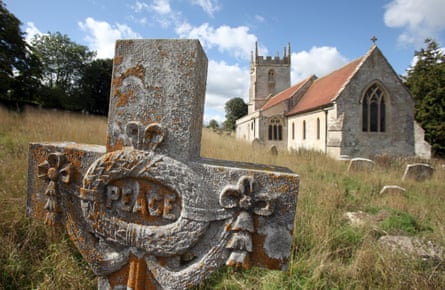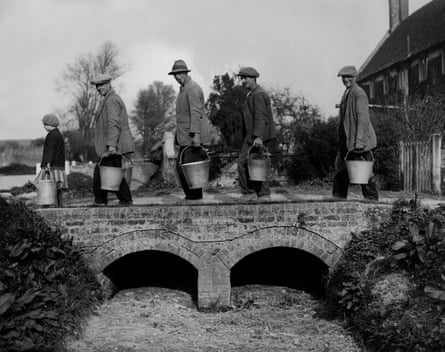A line of London buses is crossing Salisbury Plain. It looks like someone has taken a red pen to the map. At the wheel of the leading bus is Peter Hendy, AKA Lord Hendy, AKA the boss of Network Rail. He’s a great man for old Routemasters, owns two, and is the driving force – literally – of this annual jaunt to the abandoned village of Imber.
“It’s the bus equivalent,” he says, raising his voice above the engine, “of going to the north pole.”
Well, up to a point. The journey only takes 25 minutes from Warminster, but does mean driving into the Salisbury Plain training area, Ministry of Defence land, usually off limits to civilians. Tanks, used for target practice, rust at the roadside. Ivy enshrouds caterpillar tracks and a crow perches on a gun barrel. Notices warn that, because of “unexploded military debris”, we should on no account leave the carriageway. The vibe is Summer Holiday meets A Bridge Too Far.
The training area covers a great splodge of Wiltshire. It is an odd mix of the bucolic and bellicose. Live firing takes place on most days of the year, and millions of large-calibre rounds have been discharged over the decades; yet more than half the area is a site of special scientific interest and it contains a couple of thousand ancient monuments. It is a good place to be a soldier, a stone-curlew, or a standing stone.

Imber, our destination this morning, was sacrificed to war. It had long been a byword for isolation: the loneliest village in England, so-called. There was even a rhyme about this: “Little Imber on the down / Seven miles from any town.” This remoteness helped it survive the Black Death, but what was an advantage in the 14th century had become a vulnerability by the 20th. Churchill’s government saw this as the ideal part of England to prepare for D-day. And so Imber was evacuated, residents given six weeks – until 17 December 1943 – to pack up and get out. The people believed they would return in peacetime, but this was not permitted. For almost 80 years it has been abandoned, a ghost village, or rather a corpse village – a body and name without a soul. Imber is laid out in the long green miles and most of the time goes unvisited, but every now and then there is a sort of wake.
Ding! Ding! The conductor rings his bell, and we disembark for Imber. The village is open to the public on a handful of occasions each year, including the August bank holiday weekend, but Imberbus day – which raises money for charity – has a particular atmosphere of cheery English whimsy that does not quite dispel the melancholy of the place.
Old photos show a chocolate-box village, but stepping off the bus one can see at a glance that all is changed. Gone are the cottages, whitewashed and thatched; the gardens of lupins and hollyhocks; the sheep and their shepherds; the preacher and his flock. Those few buildings that do remain, such as the Bell Inn – the date of 1769 still visible on a gable – are mere shells. The only part of Imber that has survived more or less intact is the 13th-century church of St Giles. A St George’s Cross flies from the flagpole as visitors queue to enter. Inside, volunteers sell tea and cake and jars of honey. The churchyard bees, snug in their hive, are now Imber’s only residents; the beekeeper, less privileged, must come and go with a pass.
The church is interesting. On the wall to the right as you go through the door, a medieval painting shows a pair of demons doing something unspeakable to a sinner; the colours are too faded to see the detail, which is perhaps just as well. The tower is not open to the public, but Neil Skelton – the building’s custodian and guardian angel – takes me up. A spiral staircase, narrow and dark, ends at a tiny Alice-in-Wonderland door that opens to the roof. We look down at where Imber once stood. It has been replaced by a fake village, concrete houses built so that the army can train for street combat. For centuries this church served the villagers. Now, with no villagers to serve, what is its purpose?

“It stands for a community that existed for almost 1,000 years,” Skelton replies. “It stands as a memorial to those who lived here.”
The tower casts its shadow over worn and lichened headstones. I can see that a small crowd has gathered by one particular grave: the blacksmith Albert Nash, who died in 1944. His is one of the sad and romantic stories of Imber. Go close and you hear visitors telling it to one another: “He was found crying over his anvil because he couldn’t bear to leave. He died of a broken heart, so they say.” It is a modest headstone for a humble man in a little churchyard in a forsaken place, yet for this one day a year it must be the most visited grave in Britain. Forget Dickens in Westminster and Marx in Highgate, Albie Nash the Imber smith has his name spoken by thousands.
after newsletter promotion
Right next to the blacksmith’s resting place, Kelvin Nash – a member of the same family – is tending the grave of his father, Raymond. He was buried in January, the church hosting what may well be its last ever funeral. Ray Nash was still an infant when, in 1936, he and his mother left Imber after the early death of his father, a farm worker. Having spent his life without a dad, Ray had felt a longing to be laid to rest alongside him, and so, when he died at the age of 87, his family was determined to fulfil his wishes. Military vehicles accompanied the hearse and a coachload of mourners, a lone bell tolled as the coffin was carried into St Giles, Johnny Cash’s The Old Rugged Cross played, and just for a while the lonesome village had a community again – a churchful gathered to mark the passing of one of the last Imber folk.
“We can’t just visit the grave whenever we like,” Kelvin says, “so when we do visit it makes it all the more meaningful. On quieter days, it’s serene.”

Today is far from quiet. The churchyard is full of picnickers, cuppas resting on stone tombs. Before travelling here, I spoke on the phone with John Williams, one of an estimated three village residents still alive. He is in his late 80s and quite aware that he is a keeper of memory. Once all the villagers have died, Imber will become purely historical, a place of paper and ink and fading photographs. For now, though, Williams sees and hears it all clearly. The cottages and barns and smithy, the birdsong and chatter of children. His mother was the schoolmistress. Being forced to leave Imber, he says, triggered a breakdown and she spent the rest of her short life in – to use his word – an asylum.
He had no intention of visiting on Imberbus day, he told me, as he thought it gimmicky: “I like to see people visiting the village, but I want them to go there out of respect, not turn it into an Alton Towers,” he said. He believes the people of Imber should receive some sort of national recognition from government or the King. “They sacrificed everything, they gave up their homes as part of the war effort, and they weren’t even given a thank you.”
The afternoon wearing on, I leave the churchyard and walk back down the path to what used to be the high street, from where a bus is departing for Warminster. The church bells are ringing, the conductor rings as if in answer, and we return to the 21st century by way of the Wiltshire Downs.
 Top Naija News: Nigerian News, Breaking News Nigeria and World News Top Naija News is a daily news publication in Nigeria, delivering the latest breaking news in Nigeria and around the world.
Top Naija News: Nigerian News, Breaking News Nigeria and World News Top Naija News is a daily news publication in Nigeria, delivering the latest breaking news in Nigeria and around the world.



